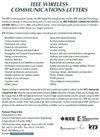抗传感干扰:ISAC 网络中的一种新型物理层攻击
IF 4.6
3区 计算机科学
Q1 COMPUTER SCIENCE, INFORMATION SYSTEMS
引用次数: 0
摘要
未来移动设备的发展趋势是感知与通信的有机融合,也就是所谓的综合感知与通信。在这封信中,我们站在攻击者的角度,设想了一种新颖的物理层攻击,称为抗传感干扰(SRJ),旨在最大限度地破坏可疑传输,同时欺骗接收器对攻击者方向的检测。为评估抗感应性能,定义了一个名为角域峰均比 (ADPAR) 的指标,并通过广义瑞利商进一步分析了该指标。然后,通过最小化 ADPAR 约束条件下的可实现速率来制定 SRJ 设计,并将其转换为凸问题,用投影梯度下降(PGD)算法加以解决。为了进一步降低计算复杂度,我们还提供了一个次优闭式解。仿真结果表明了所构想的 SRJ 设计的可行性,即在保持较低可实现率的同时隐藏攻击者的方向。本文章由计算机程序翻译,如有差异,请以英文原文为准。
Sensing-Resistant Jamming: A Novel Physical Layer Attack in ISAC Networks
The landscape of future mobile devices is poised for an organic fusion of sensing and communication, a trend known as integrated sensing and communication. In this letter, we stand in attacker’s perspective and conceive a novel physical layer attack termed sensing-resistant jamming (SRJ), aiming at maximally disrupting the suspicious transmission while deceiving receiver’s detection of the attacker’s direction simultaneously. To evaluate the sensing-resistant performance, a metric named angular-domain peak-to-average ratio (ADPAR) is defined and further analyzed through the generalized Rayleigh quotient. Then, the SRJ design is formulated by minimizing the achievable rate under ADPAR constraints, which is converted to a convex problem and solved by the projected gradient descent (PGD) algorithm. In order to further reduce the computational complexity, we also provide a sub-optimal closed-form solution. Simulation results illustrate the feasibility of the conceived SRJ design, where the attacker’s direction can be concealed while maintaining the achievable rate to a low level.
求助全文
通过发布文献求助,成功后即可免费获取论文全文。
去求助
来源期刊

IEEE Wireless Communications Letters
Engineering-Electrical and Electronic Engineering
CiteScore
12.30
自引率
6.30%
发文量
481
期刊介绍:
IEEE Wireless Communications Letters publishes short papers in a rapid publication cycle on advances in the state-of-the-art of wireless communications. Both theoretical contributions (including new techniques, concepts, and analyses) and practical contributions (including system experiments and prototypes, and new applications) are encouraged. This journal focuses on the physical layer and the link layer of wireless communication systems.
 求助内容:
求助内容: 应助结果提醒方式:
应助结果提醒方式:


